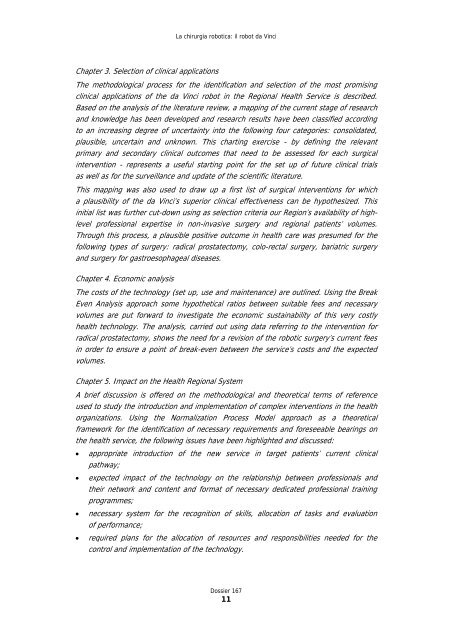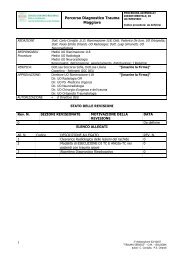La chirurgia robotica - Agenzia sanitaria e sociale regionale ...
La chirurgia robotica - Agenzia sanitaria e sociale regionale ...
La chirurgia robotica - Agenzia sanitaria e sociale regionale ...
Create successful ePaper yourself
Turn your PDF publications into a flip-book with our unique Google optimized e-Paper software.
Chapter 3. Selection of clinical applications<br />
<strong>La</strong> <strong>chirurgia</strong> <strong>robotica</strong>: il robot da Vinci<br />
The methodological process for the identification and selection of the most promising<br />
clinical applications of the da Vinci robot in the Regional Health Service is described.<br />
Based on the analysis of the literature review, a mapping of the current stage of research<br />
and knowledge has been developed and research results have been classified according<br />
to an increasing degree of uncertainty into the following four categories: consolidated,<br />
plausible, uncertain and unknown. This charting exercise - by defining the relevant<br />
primary and secondary clinical outcomes that need to be assessed for each surgical<br />
intervention - represents a useful starting point for the set up of future clinical trials<br />
as well as for the surveillance and update of the scientific literature.<br />
This mapping was also used to draw up a first list of surgical interventions for which<br />
a plausibility of the da Vinci’s superior clinical effectiveness can be hypothesized. This<br />
initial list was further cut-down using as selection criteria our Region’s availability of high-<br />
level professional expertise in non-invasive surgery and regional patients’ volumes.<br />
Through this process, a plausible positive outcome in health care was presumed for the<br />
following types of surgery: radical prostatectomy, colo-rectal surgery, bariatric surgery<br />
and surgery for gastroesophageal diseases.<br />
Chapter 4. Economic analysis<br />
The costs of the technology (set up, use and maintenance) are outlined. Using the Break<br />
Even Analysis approach some hypothetical ratios between suitable fees and necessary<br />
volumes are put forward to investigate the economic sustainability of this very costly<br />
health technology. The analysis, carried out using data referring to the intervention for<br />
radical prostatectomy, shows the need for a revision of the robotic surgery’s current fees<br />
in order to ensure a point of break-even between the service’s costs and the expected<br />
volumes.<br />
Chapter 5. Impact on the Health Regional System<br />
A brief discussion is offered on the methodological and theoretical terms of reference<br />
used to study the introduction and implementation of complex interventions in the health<br />
organizations. Using the Normalization Process Model approach as a theoretical<br />
framework for the identification of necessary requirements and foreseeable bearings on<br />
the health service, the following issues have been highlighted and discussed:<br />
• appropriate introduction of the new service in target patients’ current clinical<br />
pathway;<br />
• expected impact of the technology on the relationship between professionals and<br />
their network and content and format of necessary dedicated professional training<br />
programmes;<br />
• necessary system for the recognition of skills, allocation of tasks and evaluation<br />
of performance;<br />
• required plans for the allocation of resources and responsibilities needed for the<br />
control and implementation of the technology.<br />
Dossier 167<br />
11



